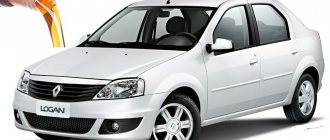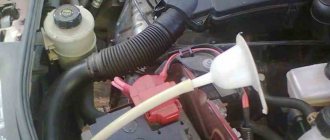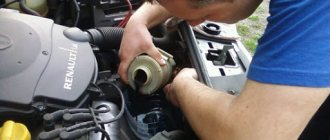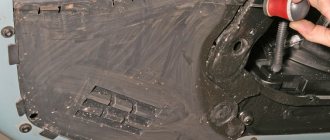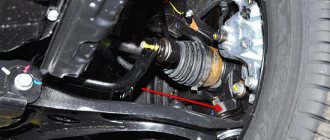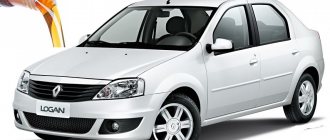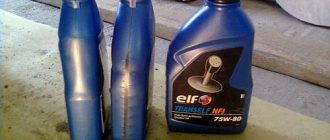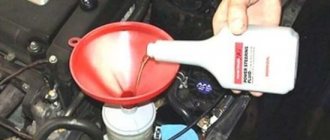For those motorists who have a Renault Logan “iron horse”, it is important to know that the coolant should be replaced every 90 thousand kilometers, or after the car has served faithfully for 6 years. Such parameters and deadlines are set by the manufacturer, and of course, this serves as a guarantee of successful operation of the car.
What kind of antifreeze you need to fill Renault Logan with, how to replace it yourself, and what signs exist for replacing the coolant, you will learn about this and much more from this article.
What and how much to fill in Renault Logan
Engine lubrication system.
Logan is equipped with only three engines: 1.4 liters. 8 valves; 1.6 l. 8 valves; 1.6 l. 16 valves.
If we take the first two engines (1.4 l. 8 valves; 1.6 l. 8 valves), then their volume does not change (3.3 l.) and neither does the oil (ELF EVOLUTION SXR 5W30). But in the case of 1.6 liters. 16 valves, then the oil (ELFEVOLUTION SXR 5W40) and volume (4.9 liters) change.
Engine cooling system.
Here you already need to pour the same antifreeze into all engines: GLACEOL RX Type D, and the volume also does not change - 5.45 liters. Before using antifreeze, it must be diluted with distilled water, the proportion is one to one. In this case, your liquid will solidify only at a temperature of -36 degrees.
Fuel.
The tank has a volume of 50 liters, you need to pour gasoline of at least 92 octane.
Transmission
For manual transmissions, ELF Tranself NFJ 75W80 or Elf Tranself TRJ 75W-80 oil is used, and the fill volume is 3.1 liters.
For the automatic transmission, Elf Renaultmatic D3 SYN Elfmatic G3 oil is used, and 7.6 liters will need to be filled.
The hydraulic booster uses Elf Renaultmatic D3 SYN Elfmatic G3 fluid and needs to be filled with 1 liter.
Brake system.
The brake fluid you need to use is ELF 650 DOT 4, this fluid is well suited for this car and you need to fill it in 0.7 liters, if you fill it with bleeding, it will take one liter.
Why is it important to change the coolant?
Automotive fluids contain not only mixtures of ethylene glycol and monohydric alcohols, but also anti-corrosion additives. Depending on the type of corrosion inhibitors, coolants are divided into:
- G-11 – based on silicate or nitrite additives.
- G-12, G-12 – based on carboxylic acids.
- G-12 – includes organics and mineral inhibitors.
Mixing all types is not recommended, although the first two are, in principle, allowed. However, it should be taken into account that the service life of the coolant in this case is reduced. Why all these subtleties? The fact is that over time, the properties of chemical additives are lost, and ethylene glycol paired with water begins its corrosive activity. This threatens:
- Possibility of thermostat jamming due to the presence of corrosion products.
- Destruction of the water pump impeller.
- Depressurization of pump bearings.
- Clogged radiator and internal combustion engine channels.
All of the above factors will certainly lead to overheating of the engine, resulting in excessive fuel consumption and a decrease in power. Regular overheating reduces the operational life of the power unit several times.
Such consequences can be avoided by timely replacement of the antifreeze that has expired in full with Renault Logan. In addition, it is important to monitor its condition by periodically looking into the expansion tank.
Optimal replacement time
Most high-quality antifreezes can last up to 3–5 years without noticeable deterioration in properties. Depending on the intensity of vehicle use, the coolant is replaced at a mileage of 60–90 thousand km. The specific period depends not only on the coolant, but also on the condition of the cooling system. If deposits have formed in the pipes, cylinder head, pump and other components, the new antifreeze can quickly become contaminated and deteriorate. To prevent this, before replacing the coolant, flush the system using special means. In the future, it is necessary to change the antifreeze at shorter intervals, taking into account the age of the car and its current mileage. If the system is regularly maintained, old antifreeze can retain its clarity and original color even after several years of use. In this case, flushing is not necessary.
Choice of antifreeze
Nowadays Renault Logan coolant is presented in huge quantities on the market, so it has become very difficult to make a choice. The article will give some recommendations for selection, and also discuss several popular types of liquids.
- Carboxylate antifreeze. Due to the fact that it has balanced conditions of excellent quality, it can be used at different temperatures. This category of coolant has basic formulas that ensure reliable protection of its properties. This type eliminates the possibility of any unexpected malfunctions occurring during vehicle operation. Therefore, many manufacturers prefer this antifreeze for their cars.
- In the nineties, the hybrid type was in great demand, but today it is also popular among many car owners. This popularity is due to its reliability and long-term preservation of its positive properties.
- The traditional type of coolant is considered outdated, although it has excellent conditioning properties that last for quite a long time
- The most modern and promising development today is the Lobrid type. Due to the fact that the composition includes all kinds of additives and additives that increase the protective properties of the heads and cylinder block, this type occupies a leading position among the favorites in this segment.
Therefore, the Renault Logan cooling system will work perfectly with this type of coolant. But despite this, everyone can choose exactly the one they see fit.
Why this particular material?
It is used as a coolant in most modern imported cars. For domestic cars, antifreeze is used in most cases. Its name translates as “non-freezing” product, so use will be effective at any time of the year, summer and winter, without problems for power units. It is obtained as a result of various additives to the water base of technical alcohols or glycerin.
These can be additives against foaming of the coolant, anti-corrosion inhibitor additives, additives against the formation of air cavities in its composition and some others. One of its main properties, in addition to its freezing temperature, is its expansion coefficient during freezing, which is significantly lower than that of water. Antifreezes are available in several classes, which we will discuss below:
- Coolant G11
is green in color, but blue and yellow colors are also available. This antifreeze is considered a hybrid, as inorganic silicate additives are added. Manufacturers guarantee its working condition for at least 3 years; it is used for all types of cooling systems. Cannot be mixed with other types;
- Composition type G12
has a red color or shades thereof. It is classified as the carboxylate type. The additives in its composition work mainly with areas of the cooling system affected by corrosion. Operation is permitted for 5 years; - Type G13
is most often found in orange. It is based on a propylene glycol base, which is more environmentally friendly compared to previous types, but its cost is much higher than other antifreezes. Best used for high-performance engines. Due to the high cost, production of such products is not organized in the CIS countries.
It is strictly forbidden to mix these materials with each other, and if the coolant is completely replaced, you need to thoroughly flush the cooling system of the power unit.
Filling into the system
To replace antifreeze with Renault Logan, you need to use a funnel. You will have to fill the liquid through the inlet pipe after unscrewing the fitting cap.
There's no need to rush. The liquid must enter the system evenly, which will avoid the formation of air plugs. You should also knead all system hoses by hand from time to time.
Filling is completed after antifreeze flows from the fitting. Here it is important to quickly close the filler hole with your hand to prevent antifreeze from escaping through the outlet valve.
With your free hand, you should quickly replace the fitting plug, and then check the fluid level in the expansion tank. It should be halfway between the minimum and maximum marks.
Currently reading: RPM jumps when starting Logan engine
If necessary, you can add the required amount of liquid.
The work doesn't end there. It is necessary to rid the system of excess air. This procedure goes as follows:
- The reliability of fixation of all covers and clamps is checked.
- The engine starts and warms up in neutral gear to 40 ° C. For precise temperature control, you can use a temperature sensor with a digital display.
- The engine is turned off and the expansion tank cap is unscrewed. You need to be careful with the lid. The pressure in the tank will be excessive.
- After bleeding the air, close the neck of the tank with one hand, and remove the cap from the fitting with the other. After liquid emerges from the drain valve, the caps return to their place.
- To release air from the heater radiator, a pump is connected and the engine is started. The latter should operate at 2,000 rpm for 10 minutes.
- After turning off the engine, you need to bleed excess pressure from the expansion tank again. It is recommended to repeat the procedure several times before full operation.
It is worth remembering that after replacing the antifreeze and carrying out all the necessary manipulations, there will still be air in the system. Its presence will be visible by temperature fluctuations in the system. Therefore, over the course of a month, it will be necessary to bleed off excess air from time to time.
How to remove all air from the system
First, you should make sure that all internal plugs have been screwed in. Next is to start the engine. After the engine has warmed up at idle speed and after it reaches 30 degrees, the engine should be stopped. Then the excess pressure is removed. How it's done? The pressure is removed by unscrewing the cap from the inlet side of the engine compartment near the expansion pipe itself.
At the same time, all work on unscrewing and further tightening should be carried out as smoothly as possible without sudden movements, since there is pressure in the system, and it is hot and cool. the mixture can burn your palms. Next, cover the throat with your hand and unscrew the pipe with the other hand. After all the basic manipulations, the palm can be removed. When all the oxygen has gone and the liquid begins to flow, the inlet can be closed and the valve screwed in. Next, tighten the tank cap tightly.
Fuel tanks for Renault Logan
| Filling/lubrication point | Refill volume | Name of oil/liquid |
| Fuel tank for all engines | 50 liters | Unleaded gasoline with an octane rating of at least 92 |
| Engine lubrication system (including oil filter) engines: | ||
| 1.4 l. 8 valves | 3.3 liters | ELF EVOLUTION SXR 5W30 |
| 1.6 l. 8 valves | ||
| 1.6 l. 16 valves | 4.9 liters | ELF EVOLUTION SXR 5W40 |
| Engine cooling system: | ||
| For all engines | 5.45 liters | GLACEOL RX Type D |
| Transmission | ||
| Manual transmission | 3.1 liters | ELF Tranself NFJ 75W80 or Elf Tranself TRJ 75W-80 |
| Automatic transmission | 7.6 liters | Elf Renaultmatic D3 SYN Elfmatic G3 |
| Power steering | 1 liter | Elf Renaultmatic D3 SYN Elfmatic G3 |
| Brake system | 0.7 liters (with 1 liter pumping) | ELF 650 DOT 4 |
How does our service center replace the coolant on Renault Logan 2?
It is unlikely that the motorist is familiar with some of the nuances of the operation itself, or he will be able to carry out some stages on his own. For example:
- When draining old antifreeze to Logan 2, a problem arises - a small sediment remains in the radiator. Our car service uses its own secrets for complete removal: washing, squeezing clamps, blowing out the tank and thermostat with a compressor. The system will be clean. After emptying, new clamps are usually installed.
- To reduce pressure, remove engine protection, commutations, etc., and also to speed up the process, a special tool is used.
- After pouring in new fluid and topping it up after running through the system, the technicians remove excess air from it so that there are no traffic jams and there are no temperature surges.
DANGEROUS! If a car enthusiast does this on his own, then when removing the blockage of the tank to reduce pressure, he runs the risk of scalding his hands with heated antifreeze.
How to fill?
The procedure for filling the system with new fluid occurs according to the following scheme:
- Fill coolant through the neck of the expansion tank until antifreeze comes out of the air bleeder hole.
- Screw on the cap of the expansion tank and the fitting cap.
- Start the engine and wait for the cooling system fan to turn on, then stop the engine.
- After the engine has cooled, bleed the air using the fitting and check the coolant level, if necessary, bring it to normal.
- Install engine crankcase protection.
Some car enthusiasts are wondering whether flushing the system is necessary when replacing the coolant on a Renault Logan car, or is it a waste of time? It all depends on the life of the car and the coolant itself.
However, the procedure will not be superfluous in any case. To do this, just insert the hose from the water supply into the filler neck, turn on running water and wait until it comes out clean.
If the radiator does not work satisfactorily, you should wash it yourself or seek help from specialists. If complex contamination is suspected, clean water is poured into the cooling system with the addition of special cleaning agents and the car is operated for 2-3 days. After this, the dirty water is drained and fresh coolant is added.
Advantages and disadvantages
The main advantages of Renault Type D antifreeze:
- Full compatibility with Renault and Nissan engines;
- The chemical composition is completely neutral to various metals, rubber and car enamel;
- Maintaining its normal liquid state up to an air temperature of -37.
- The manufacturer does not recommend diluting antifreeze with other refrigerants. In case of an emergency, it can only be diluted with distilled water or filled with the same coolant;
- Relatively high price compared to refrigerants from other manufacturers;
- It is not always possible to buy this coolant in regular auto stores.
How to replace antifreeze on Renault Logan?
Replacing antifreeze on a Renault Logan includes draining the fluid, flushing the system if necessary, and adding new antifreeze. Knowing the precautions and what tools should be prepared will help you replace antifreeze on Renault Logan, in particular, as well as on Renault Sandero and Renault Koleos, without difficulty.
A complete replacement of antifreeze on Renault Logan is possible using the following tools and consumables:
- To protect the skin, gloves and thick rags made from natural fabrics are used;
- Tools: ten key for removing crankcase protection;
- screwdriver;
- hose clamps;
- pliers.
- 6 liters of water, which are mixed with ELF GLACEOL RX Type D Renault 7711428132 antifreeze in a ratio of 1/1;
So, how much coolant is needed to replace antifreeze in Renault Sandero and Logan, and which one should you choose? Until 2009, Renault recommended TOTAL GLACELFAUTOSUPRA. Now, this product is practically not found on sale, so a product such as ELF GLACEOL RX TypeD is relevant.
The liquid described above is a concentrate, which is diluted with distilled water in a ratio of 1/1. Owners of Renault Logan with 1.4 and 1.6 engines purchase 5.5 liters of antifreeze. Three 1-liter canisters are diluted halfway with water. The remaining half liter of the finished liquid is used if necessary to add the product to the tank.
Preparing to replace antifreeze: important tips and tricks
For drivers of a car of this brand, it is better to replace the coolant in advance, namely when it becomes characteristically dirty-brown. In this case, the liquid will become unpleasant and smell sharp, and such changes will occur after 60 thousand kilometers.
To prepare for a simple operation to replace antifreeze, you will need several necessary items, including tools and consumables.
- It is important to prepare several types of wrenches, among which there should be open-end and cap options.
- You should have pliers and a screwdriver on hand.
- To drain the waste liquid, you need to prepare a wide container with low sides, which would correspond to a volume of 6 liters.
- Many drivers use the neck of a plastic bottle as a funnel.
- It is necessary to stock up on rags and cloth or rubber gloves.
Undoubtedly, for convenience, you can use an inspection hole, since in the absence of one you will have to climb under the car and perform all the necessary manipulations while lying on the floor or ground. Before starting work, the engine must be completely cooled, and the valve located at the neck of the expansion tank must be unscrewed to reduce excess pressure in the cooling system. After the cover is removed, you will hear a characteristic sound, after which the cover should return to its place.
Unfortunately, Renault does not have any precautionary plugs or other devices for the release of used antifreeze, so it is drained after removing the system pipes. To begin, remove the lower hose from the radiator, unscrew and remove the tray protecting the crater, then place a container prepared in advance under the radiator. It is more convenient to carry out this work in an inspection hole, then you can throw a board over the hole and install a container on it to collect the waste product.
How to flush the cooling system in a Logan and replace the coolant?
When the car owner has already decided which coolant to fill, you can move on to the next stage. Before replacing, you should give the engine time to cool, and then unscrew the filler plug on the radiator, thereby ensuring that the system is depressurized.
- We install the car on an overpass or pit (you can use a lift).
- Removes the plastic protective panel of the pallet.
- We disconnect the pipe from the lower outlet of the radiator and drain the coolant into a specially selected (according to capacity) container. To ensure that the liquid is drained completely, you should unscrew the plug on the motor block (if it is structurally absent, disconnect the pipes from the thermostat housing).
- When flushing the system, we assemble the circuit together (we connect the previously removed pipes) and fill it with distilled water (it is possible to use a special cleaning additive). We start the Renault Logan engine and load it with various modes for a certain time (depending on the type of “flushing”).
- Using the previously described technology, we disassemble the circuit, drain the flushing liquid, and put it back together (pay attention to the careful tightening of the clamps on the pipes).
- We fill the system with refrigerant, observing the recommended level. We start it up and check the circuit for leaks. Attention! When using concentrate, pay attention to the manufacturer's instructions regarding the proportions for preparing the mixture (with distilled water).
Low-quality antifreeze can cause harm to the elements of the cooling circuit - cause pockets of corrosion and contribute to the acceleration of the formation of deposits. It is better to immediately and permanently decide which antifreeze to fill.
Renault Duster owner reviews all disadvantages
Mini caps for stamped Renault Duster wheels
Front brake pads Renault Duster 1.6
Drawing conclusions
Like any Renault Logan car, 1.4 and 1.6 engines require attention and quality maintenance. It is recommended to change the coolant every 2 years. Be sure to pay attention to the type of coolant you will be pouring into your car. This operation is simple, so you can do it yourself. You should choose high-quality coolants, paying attention to the compatibility of this liquid with the modification of your car, because a lot depends on what kind of antifreeze you fill.
What kind of antifreeze is poured into Renault Logan at the factory - we lay out all the nuances
It is not recommended to add antifreeze - it is better to change it
Antifreeze is a coolant that is necessary for the proper operation of the vehicle engine, as well as the entire cooling system. For these reasons, the antifreeze level must be monitored and replaced as necessary.
Neither a driver with many years of experience nor a novice will argue about how important the use of antifreeze is in Russia and the importance of its timely replacement. However, not everyone is familiar with which fluid is best to use on Renault Logan 2 and how to fill it correctly (the procedure for foreign cars of the latest models is somewhat different from domestic cars). In this regard, our car service specialists will tell you more about this.
A common mistake made by many Renault Logan car owners is that they do not know what kind of coolant should be poured into the cooling system. How reliably the car will be operated depends on the correct choice. Therefore, it is important to know the features of choosing antifreeze, as well as which type of refrigerant is better.
Currently reading: Renault Logan trunk lock does not close - All about Lada Granta
- 1 Choice of antifreeze
- 2 Flushing the system and replacing the refrigerant
The Renault Logan car has become very popular in Russia in a short period of time. Car enthusiasts highly appreciated its good maintainability, reliability and low purchase price.
To keep it in working condition, it is enough to undergo periodic maintenance. Changing the coolant is one such item. It’s easy to cope with the task, if you know the nuances, then there shouldn’t be any problems when replacing it yourself.
To maintain longevity in engine operation, it is necessary that all systems work harmoniously and in tact. And regular maintenance of the cooling system is one of these necessary procedures.
The manufacturer regulates the replacement of coolant (coolant) in Renault Logan, Daster, Sandero and Largus cars every 3 years or 90 thousand km - this is indicated in the car’s operating instructions. In practice, antifreeze (in our country drivers call it antifreeze) has to be changed more often - the shelf life is affected by the temperature, the condition of the engine and the quality of the coolant.
Determining that the antifreeze resource is coming to an end is simple - open the cap of the expansion tank and look inside. Visually, the need for replacement is indicated by loss of color, the appearance of an unnatural brown color and sedimentation. You will find out that the freezing temperature of the coolant does not correspond to the norm by measuring the density with a special hydrometer.
Before starting the replacement, we stock up on worm-drive clamps for pipes with a diameter of 20-30 mm and 35-55 mm. We place the car on a flat horizontal platform, allowing the engine to cool if necessary. In order not to drain the toxic liquid onto the ground or garage floor, we take a container for used antifreeze. We carry out further work in accordance with the instructions provided.
Even a novice car enthusiast will not argue about the importance of the cooling system during engine operation. There is also no doubt about the need for a timely change of coolant, since expired refrigerant can cause many troubles.
For those motorists who have a Renault Logan “iron horse”, it is important to know that the coolant should be replaced every 90 thousand kilometers, or after the car has served faithfully for 6 years. Such parameters and deadlines are set by the manufacturer, and of course, this serves as a guarantee of successful operation of the car.
What kind of antifreeze you need to fill Renault Logan with, how to replace it yourself, and what signs exist for replacing the coolant, you will learn about this and much more from this article.
A car, as everyone knows, consumes not only gasoline, but also contains additional filling fluids.
But often car owners go to a service center because they don’t know how and how much to fill antifreeze, hydraulics, motor oil into the engine, etc. And that’s why go to a service center and pay your own money when you can do it all yourself .
If you are the owner of Renault Logan, then you are very lucky that you have come to this page, because we will talk about this particular car.
Renault Glaceol RX Type D is a concentrate and ready-made coolant that is suitable for use in engine cooling systems of modern cars, especially for cars manufactured by the Renault-Nissan concern.
Ready-to-use coolant has a freezing point of -21°C, which, of course, is not suitable for Russian regions, so it is recommended to use concentrated antifreeze diluted with water in a ratio of 50%/50%, which corresponds to a crystallization temperature of up to -37°C.
Neither a driver with many years of experience nor a novice will argue about how important the use of antifreeze is in Russia and the importance of its timely replacement.
However, not everyone is familiar with which fluid is best to use on Renault Logan 2 and how to fill it correctly (the procedure for foreign cars of the latest models is somewhat different from domestic cars).
In this regard, our car service specialists will tell you more about this.
Features of Sintec Multifreeze antifreeze
If you don’t know what antifreeze to fill, there is no need to waste time deeply studying the technical documentation for the car and searching for a suitable fluid in specialized stores. There is a universal Multifreeze composition from Sintec, which is suitable for almost all models and brands of cars. The liquid has a unique chemical formula and does not contain aggressive substances that can cause corrosion of metals and destruction of seals. Among its main advantages:
- durability. If the cooling system is fully serviced and not contaminated with deposits, the multifreeze can be used throughout the entire service life of the vehicle. You just need to periodically check its condition and make sure that the coolant does not become cloudy (for example, this can happen when oil gets into the cooling system through broken gaskets);
- compatibility with other compounds. Multifreeze can be safely mixed with antifreeze G11, G12, G12+ and G12++ of any color. This is convenient when you need to add coolant to the system, but the car owner does not have information about the brand and type of fluid that is currently used in the car;
- versatility. Sintec Multifreeze coolant can be used in cars of any model and year of manufacture. Its applicability does not depend on the car’s mileage, engine condition and other factors.
What antifreeze to use for Renault Logan
First, you should clearly understand the following rule: you should only pour coolant into a clean system. This will allow the new antifreeze not to lose all its qualities when mixed with a used product.
The recommendations of the official Renault Logan dealer come down to a type “D” product, ELF brand, called “GLACEOL RX Type D 1L Renault 7711428132”, manufactured by Total. In stores, this product is offered in the form of a concentrated solution in one-liter containers.
Its chemical composition contains the substance ethylene glycol, distilled water and additives consisting of components such as an aqueous solution, glycerin and alcohol. Ethylene glycol and water are the basis of the liquid, which makes up 96 percent of the total volume, the rest is additives.
Before using the concentrate, it must be diluted with distilled water in a ratio of 50X50. And as a container for dilution, you can use plastic bottles of one and a half or two liters. The resistance to winter temperatures of the finished antifreeze inspires confidence; it does not freeze at -35.40 degrees below zero.
Antifreeze from the manufacturer Total is safe for plastic and rubber products, as well as for containers painted with paint or varnish. In order to completely fill Renault Logan with new coolant, it is necessary to prepare 608 liters of working product the day before, its quantity depends on the appetite of the engine.
Antifreeze type GLACEOL RX Type D costs from 330 to 350 rubles per liter, but it is advisable to purchase from trusted sellers or official dealers so as not to “run into” a fake. Distilled water is also sold in specialized auto stores and can be purchased without any problems.
Reviews
Nikolai, 30 years old Good antifreeze, does not freeze even in the most severe cold. It has to be changed every two to three years. Overall I recommend it.
Maxim, 24 years old I have no complaints about this refrigerant, the only negative is the inflated price.
Yuri, 40 years old I always use this original antifreeze as I try to take care of my car and use only original products.
Evgeniy, 53 years old Having studied reviews on the Internet, I still could not understand how this coolant differs from analogues except for the price. Antifreeze may be good, but its cost is not justified.
When Renault Logan 2 antifreeze becomes unusable - replacement is necessary
When should I replace this car?
The manufacturer recommends changing the antifreeze fluid after every 90 thousand kilometers.
Although the latest brands allow you to increase this period (up to hundreds of thousands), you should trust your eyes more, that is, check. If the color of the antifreeze has changed, there is no need to delay.
This can happen after a couple of years - it all depends on the condition of the fuel system and cooling system and their operating conditions.
The fact that the life of the old liquid has been exhausted is indicated by its color and smell:
- Antifreeze becomes cloudy and darker.
- It will give off a stronger smell.
What does the technician use to replace antifreeze, besides the liquid itself? The tools are listed below:
- pliers;
- screwdriver;
- standard set of keys;
- container for draining old antifreeze;
- protective gloves (you can just use cloth ones, but rubber ones are better);
- funnel for filling.
Also, an experienced master will always have a rag or rags on hand. Maintaining cleanliness and accuracy in this matter is one of the primary tasks.
But the main thing is not so much the presence of the tool itself, but experience. This will eliminate mistakes that lead to dire consequences.
What happens if you use the wrong liquids?
To increase the effect, some car enthusiasts who independently replace antifreeze allow mixing of different types. It is highly not recommended to make a mixture containing organics and carboxylic acids. Example: in our car service center they will never mix G-11 and G-12. At the client's request, a mixture of G11 and G12 can be prepared. Otherwise:
- The service life of the liquid itself is reduced.
- Over time, the risk of corrosion increases, which can lead to dire consequences:
- thermostat failure;
- clogged radiators and engine channels;
- wear of bearings and water pump impeller, etc.
- the engine will overheat, which means it will wear out, lose power and consume more fuel.
Design features
The main elements of the cooling system of a French car are:
- cooling fan (note that the Logan fan is electrically driven);
- a centrifugal pump with blades, its operation is ensured by a toothed belt drive (timing belt), directly from the crankshaft pulley, providing forced circulation of cooling fluid (usually antifreeze);
- Logan radiator made of aluminum alloy, equipped with an expansion tank, provides cooling of the liquid and removal of excess liquid formed during heating;
- Renault Logan thermostat regulates the supply and temperature of antifreeze;
- power sensor;
- heater radiator (another name for heater radiator), needed to cool the fluid in the heater;
- hoses (radiator outlet and inlet, as well as heater radiator, steam outlet, filler), pipes (cylinder head exhaust) and connectors for connecting all system components.
Currently reading: Replacing the left drive oil seal in Renault Logan: step-by-step instructions with photos and videos - New Logan
The operating principle is based on the fact that cooled liquid is supplied directly from the radiator to the system, directly to the pump. The pump pumps antifreeze under pressure to the cylinder block and other components of the power unit. The liquid cools the engine and is supplied to the thermostat; if its temperature does not exceed the set one (89°C), then the thermostat is closed.
Then the antifreeze is supplied to the heater, cooled by the heater radiator, transferring heat to the cabin if necessary, again supplied to the pump and the cycle repeats. This is the so-called small circle of circulation. If the temperature of the coolant exceeds the set one (89°C), the thermostat partially opens (the thermostat can open completely when the antifreeze temperature is above 95°C), it enters the radiator, where it is cooled using the air flow that is formed when the car moves and the fan operates with electric drive, and again supplied to the pump, the cycle repeats. This is a large circle of circulation.
Excess liquid formed during heating enters an expansion tank equipped with an inlet and outlet valve, and antifreeze is poured into it.
Another big problem is air in the cooling system. It is released using a fitting during refueling.
On modifications equipped with air conditioning, repair of the cooling system has a number of differences that our technical center technicians take into account when working.
Malfunctions and methods for eliminating them
The main symptom of a faulty cooling system is engine overheating; in some cases, the engine cannot reach operating temperature (as a rule, in this situation the thermostat needs to be replaced). And another characteristic malfunction is a constant decrease in the level of coolant in the system.
Diagnosis of faults in this case by car mechanics of the Technical Department is carried out visually, and the following is determined:
- the level of antifreeze in the expansion tank (focusing on the MIN and MAX lines), including the color of the coolant and the presence of foreign impurities (doing this yourself, especially with a running, hot engine, is dangerous to health);
- general condition and degree of tension of the pump drive belt (in some cases, the technicians of our technical center replace the pump);
- the absence of particles in the system elements (radiator, fan) that impede the air flow, this is a typical malfunction; in some cases, the radiator may need to be replaced;
- presence of traces of coolant leakage directly in the engine compartment (possible depressurization of the system).
Is the engine overheating or leaking coolant? Contact Technical Services immediately. We have in stock all Logan spare parts necessary for high-quality and prompt repair of the cooling system, which is performed by experienced and qualified craftsmen using modern equipment using special tools.
We work for you seven days a week from 9:00 to 21:00.
We service Renault cars.
Main replacement steps
- Wait until the engine temperature drops and the pressure in the system normalizes. If you remove the cap while the engine is hot, the jet of hot antifreeze can cause severe burns.
- After the engine has cooled, lift the car on a lift and drive it onto an overpass or inspection hole.
- Drain the old antifreeze from the radiator and cylinder block by unscrewing the corresponding plugs.
- Analyze the condition of the waste fluid: if it contains jelly-like clots, rinse the circuit.
- Tighten the plugs on the radiator and cylinder block.
- Refill with new antifreeze. It is better to fill through the radiator neck rather than through the expansion tank. In this case, the coolant will be distributed more quickly throughout the system and flow through the channels.
- Over the next few days, check the coolant level in the expansion tank. It may decrease slightly until the liquid finally fills all the channels in the system.
- If necessary, add the missing antifreeze so that the level is between the Min and Max marks on the expansion tank.
Causes of leaks
Antifreeze leaks are a fairly common problem that requires immediate attention. Even minor leaks can turn into serious leaks at the worst possible time. As a result, the engine overheats, which leads to problems with the motor. It is important not only to find the place where the leak occurred, but also to completely eliminate the cause.
The engine cooling system consists of a number of elements, as well as connecting pipes. Antifreeze, which is a mixture of water and coolant, heats up as the internal combustion engine heats up. As a result, the causes of leaks can be:
- defects in connections responsible for tightness and tightness;
- problems with the elements of the cooling system;
- wear of elements;
- mechanical damage to the elements of the car cooling system;
- errors when assembling elements after repair work;
- violation of the rules for using a car;
The primary sign that there is a problem in the system is the level of antifreeze in the expansion tank. Its constant decrease indicates leaks.
A characteristic sign of a leak is wet spots and collected drops. If this cannot be detected by visually inspecting the parts, then all components of the cooling system should be checked.
More serious problems with antifreeze leakage include cracks in the block and cylinder head.
As a result, the antifreeze level drops and the lubricant loses its properties. It is necessary to immediately eliminate the problem, as the unit wears out and may jam and fail.
In conclusion, it is worth noting that in order to avoid breakdowns, leaks and the need to completely replace antifreeze on Renault Logan, you should not add water to the antifreeze when the fluid level decreases in the cold season. The percentage ratio of the required concentration is violated, which leads to freezing of the coolant in the system. The risk of damage to the cooling system and engine failure increases.
About types of liquids
- Carboxylate is a type of antifreeze that is endowed with balanced quality conditions, which allows it to be used in different temperature conditions. This category of coolants is traditionally characterized by a high-quality base formula that provides reliable protective properties. Such a refrigerant will eliminate the possibility of unexpected malfunctions in the cooling circuit of the Renault Logan engine during the operating period. Most manufacturers highly recommend or even use carboxylate antifreeze in their car models.
- Hybrid - this type was widely used in the nineties, but even today it is a very popular alternative, preferred by a large category of car owners, including Renault Logan. The liquid has excellent performance in terms of reliability and duration of preservation of its protective properties in terms of elements of the cooling circuit.
- Traditional is a type of liquid that is considered obsolete in comparison with the previous ones, but has good conditioning properties and is capable of maintaining them for a long time during operation.
- "Lobrid" is one of the latest and most promising developments. It takes a worthy place among the leaders in this segment due to the use in its composition of various additives and additives that help improve the protective properties of cylinder blocks and their heads made of aluminum.
We recommend using this particular type of fluid for the engine cooling system in Renault Logan. Although, everyone decides for themselves which coolant to pour into their car.
For many amateurs, the main criterion when choosing antifreeze is its color, which leads to a not entirely correct opinion about the identity of the qualitative properties of different liquids when the color scheme matches. And here again the question arises: what kind of antifreeze should I use? In fact, the color of the refrigerant acts as an indicator in case of leaks from the cooling circuit.
Therefore, if yellow refrigerant is poured into the system in a particular car, this does not mean that it is incapable of combining with red or green liquid. Combination is not a mandatory procedure, although it is better to find out about the variety of colors of liquids suitable for the Renault Logan model from an official representative of the manufacturer.
Removing old fluid
Do not attempt to pull off the lower radiator hose without first loosening the tension clamp. When removing the locknut, you need to inspect the clamp. If it is original, it will have to be replaced. The French automaker supplies disposable clamps.
Next you need to proceed in the following order:
- The hoses are removed from the radiator and the expansion tank pipe. This will allow you to quickly drain the Renault Logan antifreeze and ensure a high-quality replacement in the future.
- Due to the design of the car, simply disconnecting the hoses will not completely get rid of antifreeze. Some of it will remain in the radiator. To completely remove antifreeze, you need to remove the tubes from the thermostat hoses and lower their container with the drained liquid.
- The cooling system is purged using a compressor. Air must be supplied simultaneously - through the expansion tank and thermostat hoses. The pressure should not be excessive to prevent damage to the radiator honeycomb.
- After the cooling system is completely empty, you can return all hoses and clamps to their place.
After the procedures have been completed, you can begin to fill in new fluid. The choice of antifreeze is up to the car owner.
There was a time when Renault engineers recommended using antifreeze called GLACELF AUTO SUPRA produced by Total. It is easily recognized by its orange color. But today the automaker recommends using Renault Glaceol RX Type D.
Antifreeze of this brand is available in the form of a concentrate, and before filling it must be diluted with distilled water.
Find out more about the new Logan
- Do-it-yourself engine diagnostics: Renault Logan, 1.6 l., 2013 on DRIVE2
- What is in the hood of Renault Logan
- Repair Renault Logan: Replacing the bearing and clutch release fork
- 2 din car radio logan on AliExpress - buy online at a good price
- What gasoline to fill in Renault Logan 1st generation
- Options and prices of Renault LOGAN Stepway 2022 in Moscow from the official dealer AVANTAME
- Diagnostics and replacement of the front wheel bearing Renault Logan | New Logan
- How to remove the heater on a Renault Logan video
Please pay attention before replacing!
Coolant has leaked from the thermostat pipe
If you have to completely replace the coolant, then pay attention to the condition of the radiator, pipes, hoses, and thermostat (it is not a very reliable part of the system). Once you have made sure that everything is in perfect order, you can get to work without any problems.



